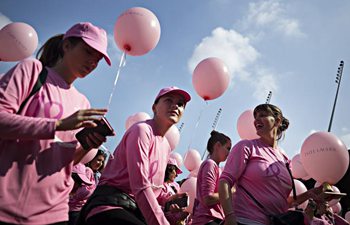LOS ANGELES, Sept. 25 (Xinhua) -- Researchers at the University of Utah say they have identified a new treatment to reverse this defect in mouse pups in-utero, potentially opening the door for similar treatment to prevent this common birth defect in people.
The findings, published this month in the peer-reviewed scientific journal Development, showed the cleft palates of all the tested unborn mice, or "pups," were successfully reversed and the 18-months treatment found no adverse health effects.
Using mice as a model, the researchers originally had planned to clarify the role of two sets of genes, PAX 9 and Wnt genes, in regulating tooth formation. Unexpectedly, for the first time, their work revealed the involvement of the Wnt pathway during palate fusion.
Like people born with a cleft palate, the two sides of the palate fail to fuse in mice lacking the gene PAX9. At the molecular level, researchers found another abnormality. The mice missing PAX9 had an increase in two genes, called Dkk1 and Dkk2, that block the Wnt signaling pathway. That ultimately leads to a cleft palate, according to the study.
The researchers then administered a pharmacological Wnt-based treatment that inhibited Dkk (WAY-262611) intravenously through the mother rat's tail vein during a critical window of the pups' gestation, when palate formation is initiated and ongoing.
Treatment restored palate fusion in all of the pups tested. The drug works by blocking the Dkk genes and restoring the Wnt pathway.
"Clearly, there is more work to be done prior to implementation for humans, but it seems feasible to translate this research into Wnt-based treatments for people," Dr. Rena D'Souza, a professor of dentistry at the University of Utah and the lead author of the study, said in a statement.
Future work is necessary to investigate if it is safe and effective to deliver a drug to human babies in-utero or directly to newborns with palate defects, researchers say.
Cleft palate, one of the most common types of birth defects, affects 1 in roughly 1,574 infants born in the United States.
According to the Centers for Disease Control and Prevention, each year in the United States, about 2,650 babies are born with a cleft palate and 4,440 babies are born with a cleft lip with or without a cleft palate.
Children with a cleft palate require reconstructive surgery and complex life-long treatments.

















